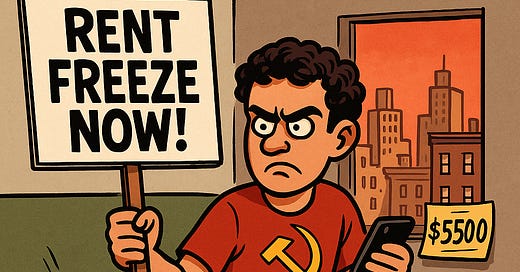Rent-Burdened and Seeing Red: NYC Socialist Zohran Mamdani’s Upscale “Precariat”
ProTip: High Housing Costs Can Force Political Change - by Mac Larimer
Once upon a time in New York City politics, the young urban professionals, the so-called “Yuppies,” voted for Giuliani in the nineties and Bloomberg in the 2000s. Today’s equivalents are texting their support for socialist Zohran Mamdani.
Welcome to the paradox of the 2025 New York City Democratic primary. Upper-income neighborhoods voted for the socialist, but poorer areas didn’t. Zohran Mamdani’s surprise primary win didn’t come from the poorest outer-borough neighborhoods or a late-breaking celebrity endorsement. It came from neighborhoods with cold brew subscriptions and take-out deliveries—places that used to vote for earnest “good government” reformers, not socialists with populist promises.
Andrew Cuomo won Staten Island and the black working-class districts of the Bronx. Mamdani took hipster Williamsburg, Lower East Side, and those leafy bits of Brooklyn where people own yoga mats and rent Netflix documentaries about capitalism. The zip codes that once flipped for Rudy and Bloomberg are now rallying for rent freezes, free subway fares, municipal childcare, and public grocery stores. Think Takoma Park on steroids.
This wasn’t a working-class revolt. It was a vibes revolution with a rent-burdened backbone. Mamdani’s supporters are more likely to stream Chapo Trap House than shop at Target. They're economically vulnerable—one paycheck away from having to turn their Substack subscriptions into GoFundMe campaigns.
And somehow, improbably, they found their political avatar in Mamdani.
There’s a rich irony—emphasis on irony—in watching today’s young college-educated city-dwellers follow a similar emotional arc that Rust Belt voters traced a decade ago. Back then, it was working-class Midwesterners, lacking college degrees but fluent in economic despair, who abandoned the Democratic Party for Trump. Their factories were gone, their towns hollowed out, and they wanted someone who’d smash the system.
Fast forward to 2025: the vocabulary has changed, but with its own distinct set of grievances. Now it’s the credentialed and caffeinated—young, urban, and broke—ditching centrist Democrats for a socialism-flavored populism. They’ve got diplomas but are drowning in student debt, and they’re fed up with a system that hands them record rents and no path to stability, let alone a home of their own , ever. Their populism rhymes with MAGA, but speaks fluent NPR.
The Mamdani moment signals the breakdown of the Blue State model. New York promised opportunity, but it got red tape and monopolies. It offered mobility and delivered congestion pricing. Since 2023, prices in the New York metro area jumped 7.5%—outpacing the national average. Rents for a median-priced two-bedroom hit $5,500 a month, the fastest increase in the country. Few New Yorkers can afford to pay only 30% of their salary on rent. But if they did, as recommended by financial planners, their housing would require an annual income of $220,000. And this is not for a luxury apartment, this is for an apartment squarely in the city’s middle.
Without new housing being built, the city’s vacancy rate dipped to 1.4%, the lowest since 1968. If you want a visual metaphor, think: musical chairs, but the music is a $3 swipe and the last seat is a Bushwick walk-up with black mold.
Joel Kotkin calls their predicament “neo-feudalism.” In another era, this class drifted right—toward Giuliani, toward Bloomberg, toward orderly tax policy and effective law enforcement. However, the 2025 version has taken a sharp turn to the left politically. While they may have started to radicalize in college lecture halls, Zillow completed the job. In Kotkin’s turn of a phrase, the socialist base is not the proletariat, but the precarious “precariat.”
Mamdani’s base is wondering how to Venmo their roommates for last month’s utilities. They drink fair-trade coffee and vote like longshoremen used to a century ago. If the ‘80s yuppie was “socially liberal, fiscally conservative,” Mamdani’s millennials and zoomers are “culturally radical, economically precarious.”
And the Democrats? The old coalition of working-class workers and black churches is fading. In its place: a renter army with advanced degrees, student debt, and just enough money to order from Seamless—but not enough to get on the property ladder.
Once cities like New York drew in aspirational strivers, now it’s a city of angry survivors, voting for socialism in vintage jeans.







